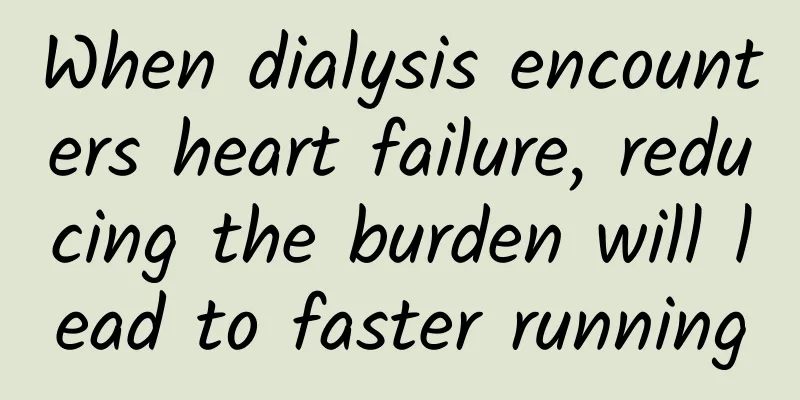When dialysis encounters heart failure, reducing the burden will lead to faster running

|
Hemodialysis and blood purification, as the name implies, are to purify toxins from the blood. Patients with late-stage chronic kidney disease [1] (stage five) are commonly known as "uremia". The kidney is the second most important detoxification organ in the human body after the liver. If renal excretions such as creatinine and urea nitrogen cannot be excreted normally and continue to circulate in the blood, it will lead to hypertension, heart failure, severe hyperkalemia, acid-base imbalance, gastrointestinal symptoms, anemia, abnormal mineral bone metabolism, hyperparathyroidism and central nervous system disorders, and may even be life-threatening. Therefore, hemodialysis is the main treatment for patients with renal failure, used to maintain life and improve quality of life. However, hemodialysis patients may experience a variety of complications during treatment, one of which is heart failure. Heart failure, or HF, is a condition in which the heart cannot effectively pump blood to meet the body's needs. Among the 120 million CKD patients in my country, the proportion of patients with HF is higher than that with coronary heart disease. Literature reports that 44% of dialysis patients have heart failure, and nearly half of the patients have decreased ejection fraction (EF) values on cardiac ultrasound. More than one-third of new hemodialysis patients have heart failure. Among MHD patients, vascular disease accounts for 40% to 50% of deaths, and the risk of cardiac death is 10 to 20 times higher than that of patients without chronic kidney disease. Therefore, effective control of heart failure and improving the prognosis of patients with heart failure are the main links in reducing mortality, and the occurrence of heart failure should be highly valued and diagnosed and treated early. There are many possible causes of heart failure in hemodialysis patients, including multiple risk factors, including traditional risk factors and dialysis-related risk factors: Traditional risk factors: 1. Hypertension: MHD patients lose their ability to regulate blood pressure, have their renin-angiotensin system (RAAS) activated, and have their sympathetic nervous system excited, causing their blood pressure to remain elevated for a long time. This can lead to increased left ventricular pressure load and volume overload, further inducing ventricular remodeling and collectively causing heart failure. 2. Diabetes: Diabetes macrovascular complications, microvascular complications and diabetic myocardial damage promote the occurrence of cardiac complications in MHD patients. 3. Dyslipidemia: MHD patients often have hyperlipidemia, which is often manifested as elevated serum cholesterol and low-density lipoprotein (LDL). LDL is easily oxidized to ox-LDL, which carries more cholesterol and deposits on the arterial wall, aggravating arteriosclerosis and causing ischemic heart disease. Dialysis-related risk factors: 1. High-volume load: Patients with uremia have low or absent residual renal function, inadequate dialysis, insufficient ultrafiltration volume, excessive drinking of water and other factors, which cause high-volume load and increase the burden on the heart. 2. Internal fistula blood flow: The normal internal fistula blood flow (AVFB) of hemodialysis is (1086±505) mL/min. If AVFB ≥ 1500 ml/min, and the larger the AVFB value, the greater the impact on cardiac function, and the more likely it is to cause heart failure. 3. Dialysis hypotension: According to research statistics, the incidence of hemodialysis hypotension is 20%~30%, which is related to the reduction of effective blood volume, decreased plasma osmotic pressure, and autonomic nervous dysfunction. Hypotension leads to insufficient cardiac perfusion and myocardial damage, which can eventually lead to decreased cardiac function and heart failure. 4. Susceptible to infection: Infection is the most common cause of heart failure. The cellular and humoral immunity of uremic patients is low, making them more susceptible to infection by pathogens. Improper care of hemodialysis access increases the risk of infection. Malnutrition in dialysis patients may aggravate the patient's immune function and increase the risk of infection. 5. Renal anemia: Low hemoglobin reduces the oxygen-carrying capacity of the blood, resulting in insufficient oxygen supply and damaged myocardium. In order to ensure blood and oxygen supply to various tissues and organs, the heart increases its compensatory work, which in the long run causes myocardial hypertrophy, eventually leading to anemic heart disease and further aggravation of heart failure. 6. Differences in dialysis modes: It was previously believed that heart failure symptoms could be alleviated regardless of the dialysis method used. Studies have now found that different dialysis modes have significant differences in the control of heart failure. 7. Others: dialysate electrolytes, dialysate temperature, calcium-phosphorus metabolism disorders, secondary hyperparathyroidism and hypercoagulable state, etc. Although there are many risk factors for heart failure, they are all controllable and preventable: 1. Control hypertension: It is currently believed that the target blood pressure for hemodialysis patients should be less than 130/80 mmHg. If the blood pressure is still higher than 140/90 mmHg after dialysis, drug intervention should be given. For patients with heart failure and reduced ejection fraction, the first-line drugs available include angiotensin-converting enzyme inhibitors (ACEI), angiotensin receptor blockers (ARB), and beta-blockers. 2. Control hyperglycemia: The 2020 Kidney Disease Improving Global Outcomes Organization (KDIGO) Clinical Practice Guidelines recommend the use of glycosylated hemoglobin (HbA1c) to monitor blood sugar control in patients with diabetes and CKD. The individualized HbA1c target range is recommended to be <6.5% to <8.0%. 3. Correcting abnormal lipid metabolism: Statins are the first-line lipid-lowering drugs for dialysis patients. The latest studies have shown that statins combined with powerful lipid-lowering drugs such as ezetimibe can significantly reduce the incidence of cardiovascular complications in patients with chronic kidney disease (CKD). 4. Correct anemia: When the hemoglobin level is controlled to >110g/L, left ventricular hypertrophy can be significantly improved and heart failure can be effectively prevented. The 2012 KDIGO guidelines recommend that CKD5D patients start ESA treatment when Hb<9g/L. The initial dose is 20U/kg, 3 times a week. There are also new blood-raising drugs, such as rosuvastatin. 5. Prevention and treatment of chronic kidney disease-mineral and bone metabolism disorders (CKD-MBD): The key to the prevention and treatment of CKD-MBD is to achieve target values for blood calcium, blood phosphorus, and intact thyroxine (iPTH). The serum corrected calcium level is maintained at the lower limit of normal, about 2.1-2.5mmol/L; the blood phosphorus level is maintained at 1.13-1.78mmol/L; and the blood iPTH is maintained at 2-9 times the upper limit of normal detection (the ideal level is 150-300pg/ml). 6. Others: prevention of infection, prevention and treatment of vascular calcification, correction of hyperhomocysteinemia, anticoagulation, etc. 7. Control of symptoms during heart failure: In patients with heart failure on dialysis, reducing volume load and improving water and sodium retention as well as blood pressure control remain key management strategies. In addition, in daily life, the following aspects can be taken to help hemodialysis patients better prevent heart failure: 1. Diet adjustment: Help hemodialysis patients develop a healthy diet plan, limit sodium intake, and avoid excessive water intake. Advise them to choose light, easily digestible foods, and encourage them to increase foods rich in minerals such as potassium and magnesium, such as fresh vegetables, fruits, and whole grains, to maintain normal heart function. 2. Regular exercise: According to the physical condition of hemodialysis patients, assist them to develop a suitable exercise plan. Appropriate and moderate exercise can enhance heart function, improve blood circulation efficiency, and help prevent heart failure. However, it should be noted that exercise should be avoided before and after dialysis to avoid affecting the dialysis effect. 3. Weight control: Help hemodialysis patients monitor their weight changes regularly, encourage them to maintain a stable weight, and avoid excessive weight gain. Being overweight will increase the burden on the heart and is not conducive to the prevention of heart failure. 4. Psychological support: Hemodialysis patients may experience negative emotions such as anxiety and depression due to the disease and dialysis treatment, which may aggravate the symptoms of heart failure. Therefore, family members and friends should give them enough psychological support to help them maintain a positive and optimistic attitude and enhance their confidence in overcoming the disease. 5. Regular check-ups: Urge hemodialysis patients to go to the hospital regularly for heart function tests, such as electrocardiogram, echocardiogram, etc., so as to detect and treat signs of heart failure in time. 6. Avoid infection: Infection is one of the important causes of heart failure. In daily life, hemodialysis patients should pay attention to personal hygiene, avoid contact with sources of infection, and reduce the risk of infection. 7. Take medication as directed by the doctor: Hemodialysis patients usually need to take multiple medications to control their condition. Family members should remind them to take medications on time and in the correct dosage, and not to increase or decrease the dosage or stop taking medications on their own. Through the above measures, we can help hemodialysis patients better prevent heart failure and improve their quality of life in many ways. At the same time, we also need to pay attention to their psychological needs, give them enough care and support, so that they can maintain a positive attitude when facing the disease. At the same time, pay close attention to the risks and symptoms of heart failure, take active preventive measures and treatments to reduce the incidence of heart failure and improve the quality of life. At the same time, patients with heart failure should seek medical treatment in time and cooperate with the doctor's diagnosis and treatment to prolong life and improve the quality of life. |
<<: Pulmonary sequestration: the mysterious “islands in the lungs”
Recommend
What causes breast pain and missed menstruation in women?
Breast pain and amnesia is a common gynecological...
Drinking during menstruation
Nowadays, young women need to drink alcohol due t...
What are the precautions for shallow immersion in the basin?
Being pregnant is a great thing. The whole family...
Is the popular sleep aid “white noise” fake science or real scam?
"My eyes were as big as bells, and I tossed ...
What behaviors during pregnancy can cause birthmarks in babies? How to avoid birthmarks during pregnancy
We all know that some pregnant mothers are relati...
What is the fungus of tofu dregs leucorrhea
Women are very familiar with leucorrhea, which is...
Can I get pregnant if I ejaculate during my period?
Menstruation is a physiological phenomenon that w...
What should I do if there is a small fleshy lump next to my nipple?
Women’s nipples are very fragile and need special...
What is the difference between Schefflera chinensis and Lucky Tree? Where should Schefflera chinensis be placed in the living room?
In Feng Shui, plants with large leaves are believ...
The bigger the head, the smarter it is? No, no, no, a truly smart head looks like this...
This article was reviewed by Dr. Tao Ning, Associ...
Is a 4 cm uterine fibroid serious?
Women with uterine fibroids are prone to vaginal ...
What medicine is good for lower body inflammation?
Gynecological inflammation in women is a very com...
What to do if my stomach hurts and my cervix is not dilating
Many people probably don't understand what ce...
[Creative Cultivation Program] Is Botox only for beauty? If it causes food poisoning, it can be very harmful!
Author: Nutritionist Xue Qingxin When it comes to...









